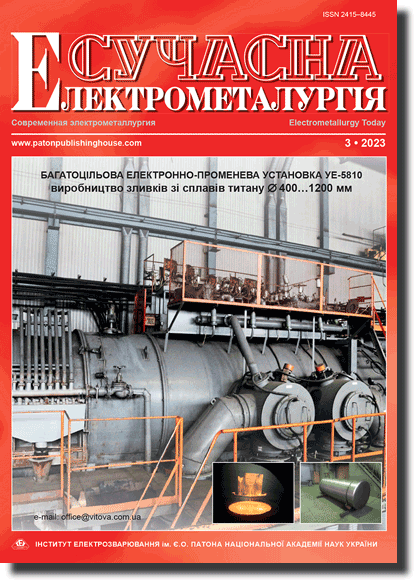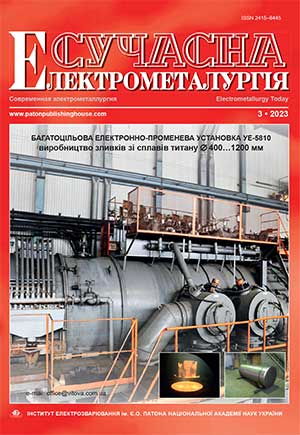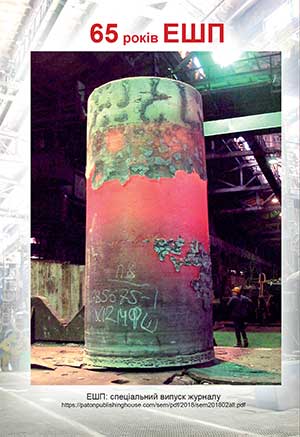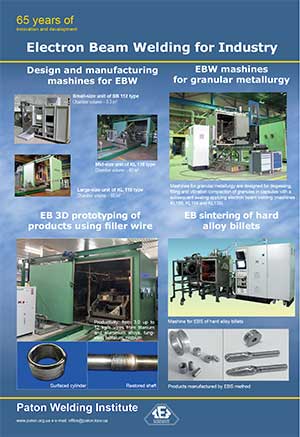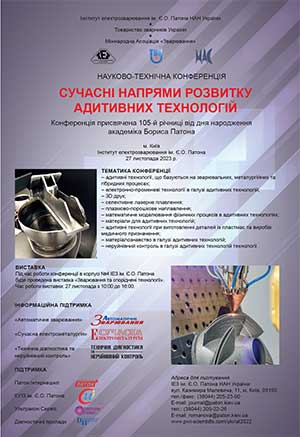| 2023 №03 (06) |
DOI of Article 10.37434/sem2023.03.07 |
2023 №03 (01) |

Сучасна електрометалургія, 2023, #3, 48-55 pages
Технології виготовлення біметалічних композитів Cu‒Al (Огляд)
І.В. Зяхор1, A.O. Наконєчний1, Wang Qichen2, Linyu Fu3, В.В. Кольцов4
1ІЕЗ ім. Є.О. Патона НАН України. 03150, м. Київ, вул. Казимира Малевича, 11. E-mail: office@paton.kiev.ua2CIMC Offshore Engineering Institute Company Limited, Yantai, Shandong, P.R. China
3Yantai Fisend Bimetal Co. Limited, Yantai, Shandong, P.R. China
4ТОВ «Ентерпрайз Текнолоджіз». 02125, м. Київ, вул. Старосільська, буд. 1У, Київ, Україна
Реферат
Мідно-алюмінієві композити широко використовуються у галузях передачі електроенергії, телекомунікацій, в авіації, автомобільній промисловості та електроніці. Огляд присвячено аналізу технологій виготовлення біметалічних мідно-алюмінієвих композитів. Показано, що переважно використовуються два металургійні способи виробництва заготовок Cu–Al композитів — безперервне литво з вертикальним заповненням серцевини (VCFC) та безперервне литво з горизонтальним заповненням серцевини (HCFC). Останній із способів найбільше підходить для індустріалізації. Розглянуто особливості фазових перетворень на міжфазній границі Cu/Al під час литва біметалічних композитів, їх термомеханічної деформації, зварювання. Показано, що границя розділу між Al-серцевиною і Cu-оболонкою є багатошаровою структурою, що складається з шарів фаз γ1(Cu9Al4), δ(Cu3Al2), η2(CuAl), ε2(Cu3Al2+x), θ(CuAl2) і евтектики α(Al)/θ(CuAl2). Для виробництва із біметалічних заготовок покритого міддю алюмінієвого дроту (copper-clad aluminium (CCA) wire) використовують способи прокатки, витяжки і зварювання. Кінцева мета огляду — визначення вихідних даних і технічних рішень для розробки ефективної технології стикового зварювання мідно-алюмінієвих заготовок при виробництві ССА композитів. Бібліогр. 32, табл. 1, рис. 6.
Ключові слова: мідно-алюмінієвий композит, покритий міддю алюміній, безперервне литво, Cu/Al міжфазна границя, інтерметалідний шар, евтектика
Received 31.08.2023
Список літератури
1. ISO 13832:2013: Aerospace — wire, aluminium alloy and copper-clad aluminium conductors — general performance requirements.2. ASTM B566-04a(2021): Standard specification for copper-clad aluminium wire. DOI: https://doi.org/10.1520/B0566-04AR21/
3. Liu T., Liu P., Wang Q.D. (2013) Research progress on copper/ aluminium bimetal composite. Mater. Rev., 27(19), 1.
4. Liu S.Y., Wang A.Q., Lyu S.J., Tian H.W. (2018) Interfacial properties and further processing of Cu/Al laminated composite: A review. Mater. Rev., 32(5) 828.
5. Jingpei Xie,, Aixia Mao, Wenyan Wang (2018) Study on interface structure of Cu/Al clad plates by roll Casting Qinghua Chang. Metals, 8, 770. DOI: https://doi.org/10.3390/met8100770
6. WANG Qudong, JIANG Haiyan (2020) New research progress on copper/aluminium bimetallic composites LIU Guoping. Material Reports A, 34(4). DOI: https://doi.org/10.11896/cldb.19050192
7. Chu Di, Jianyun Zhang, Jin-jinYAO et al. (2017) Cu–Al interfacial compounds and formation mechanism of copper cladding aluminium composites. Transact. of Nonferrous Metals Society of China, 1 November, 2521‒2528. DOI: https://doi.org/10.1016/S1003-6326(17)60279-6
8. Jianjun Zhu, Guangkai Yu, Ting Liu et al. (2018) Application of copper cladding aluminium composites in UHV portable earthing and short-circuiting wires. MATEC Web of Conf., 160(3):01004. DOI: https://doi.org/10.1051/matecconf/201816001004
9. Ya-Jun Su, Xin-Hua Liu, Hai-You Huang et al. (2011) Interfacial microstructure and bonding strength of copper cladding aluminium rods fabricated by horizontal core-filling continuous casting. Metallurgical and Materials Transact. A, 42A(12), 4088–4099. DOI: https://doi.org/10.1007/s11661-011-0785-x
10. Jun Wang, Fan Zhao, Guoliang Xie et al. (2022) Hot compressive deformation of eutectic Al–17 at.% Cu alloy on the interface of the Cu–Al composite plate produced by horizontal continuous casting. Inter. J. of Minerals, Metallurgy and Materials. 29(8), 1578‒1588. DOI: https://doi.org/10.1007/s12613-021-2276-4
11. Hanyan Lia, Wenge Chena, Longlong Donga et al. (2018) Interfacial bonding mechanism and annealing effect on Cu‒Al joint produced by solid-liquid compound casting. J. of Materials Proc. Technology, 252(2), 795‒803. DOI: https://doi.org/10.1016/j.jmatprotec.2017.10.050
12. Zhiping Mao, Jingpei Xie, IAiqin Wang et al. (2018) Interfacial characterization and bonding properties of copper/aluminium clad sheets processed by horizontal twin-roll casting, multi-pass rolling, and annealing. Metals., 645(8), 1‒17. DOI: https://doi.org/10.3390/met8080645.
13. Ying Fu, Yubo Zhang, Jinchuan Jie et al. (2017) Interfacial phase formation of Al‒Cu bimetal by solid-liquid casting method. China Foundry, 14(3), 194–198. DOI: https://doi.org/10.1007/s41230-017-6057-7
14. Yubo Zhang, Ying Fu, Jinchuan Jie et al. (2017) Characteristics of copper-clad aluminium rods prepared by horizontal continuous casting. Metals and Materials Inter., 23, 1197–1203. DOI: https://doi.org/10.1007/s12540-017-6922-3
15. Liu Xinhua, Fu Huadong, He Xingqun et al. (2018) Numerical simulation analysis of continuous casting cladding forming for Cu‒Al composites. Acta Metallurgica Sinica, 54(3), 470‒484.
16. Gubbels G.H.M., Kouters M.H.M., Dos Santos Ferreira O. (2012) Characterization of intermetallic compounds in Cu‒Al ball bonds: Thermo-mechanical properties, interface delamination and corrosion. Proc. of 4th Conf. on Electronic System-Integration Technology (17‒20 September 2012). DOI: https://doi.org/10.1109/ESTC.2012.6542123
17. Hyoung Joon Kim, Joo Yeon Lee, Kyung-Wook Paik et al. (2003) Effects of Cu/Al intermetallic compound (IMC) on copper wire and aluminium pad bondability. IEEE Transact. on Components and Packaging Technologies, 26(2), JUNE, 367‒374. DOI: https://doi.org/10.1109/TCAPT.2003.815121
18. Zyakhor I.V. and Kuchuk-Yatsenko S.I. (2001) Peculiarities of formation of friction welded joints between copper and aluminium. The Paton Welding J., 9, 24‒29.
19. Zyakhor I.V. (2000) Peculiarities of friction welding of dissimilar metals and alloys. The Paton Welding J., 5, 36‒44.
20. Kuchuk-Yatsenko S.I., Zyakhor I.V., Gordan G.N. (2002) Effect of process parameters and braking dynamics in friction welding on structure and properties of joints between copper and aluminium. The Paton Welding J., 6, 2‒7.
21. Kuchuk-Yatsenko S.I., Zyakhor I.V. (2002) Mechanism of bimetal joints formation in friction welding The Paton Welding J., 7, 2‒9.
22. Kuchuk-Yatsenko S.I., Zyakhor I.V., Nakonechny A.A. (2018) Resistance butt welding of titanium aluminide γ-TiAl with VT5 alloy. The Paton Welding J., 9, 2‒6. DOI: https:// doi.org/10.15407/tpwj2018.09.01
23. Kuchuk-Yatsenko S.I., Havrysh V.S., Rudenko P.M. et al. (2019) Development of resistance butt welding technology and prototype equipment for joining carbide bar chain ripper teeth of VK-8 material. Sci. Innov., 15(1), 72‒81. DOI: https:// doi.org/10.15407/scine15.01.072
24. Shvets V.I., Didkovskyi O.V., Antipin Ye.V. et al. (2022) Features of microstructure of joints of hypereutectoid AREAL-136HE-X rail steel in flash-butt welding. The Paton Welding J., 3, 34‒40. DOI: https://doi.org/10.37434/ tpwj2022.03.04
25. Kuchuk-Yatsenko S.I., Rudenko P.M., Gavrish V.S. et al. (2020) Operational control as a means of the evaluation of quality of welded connections for flash-butt welding of modern high-strength steels. Sci. Innov., 16(2), 66‒71. DOI: https://doi.org/10.15407/scine16.02.066
26. Kuchuk-Yatsenko S.I., Hushchyn K.V., Ziakhor I.V. et al. (2021) Structure and mechanical properties of 2219-T87 aluminium alloy joints produced by flash butt welding The Paton Welding J., 8, 27‒32. DOI: https://doi.org/10.37434/ as2021.08.07
27. Gushchin K.V. Ziakhor I.V., Samotryasov S.M. et al. (2022) Peculiarities of flash butt welding of aluminium alloys with resistance preheating using an intermediate insert. The Paton Welding J., 10, 18‒24. DOI: https://doi.org/10.37434/ tpwj2022.10.03
28. Sergeeva Yu.A., Chudakov V.A., Gordan G.N. (1989) Investigation of the transition zone in copper-aluminum joints made by magnetic pulse welding. Avtomatich. Svarka, 12, 5‒8.
29. Markashova L.I., Sergeeva Yu.A., Statsenko V.V. et al. (1991) Features of the structure formation mechanism under the conditions of magnetic pulse welding. Avtomatich. Svarka, 3, 21‒26.
30. Polieshchuk M.A., Matveiev I.V., Bovkun V.O. et al. (2020) Application of magnetic-pulse welding to join plates from similar and dissimilar alloys. The Paton Welding J., 8, 41‒45. DOI: https://doi.org/10.37434/tpwj2020.08.07
31. Dobrushin L.D., Bryzgalin A.G., Shlonskii P.S. et al. (2012) Combined explosive cladding/drawing technology for production of coaxial Cu‒Al electric conductors for aerospace application. Proc. of Inter. Сonf. on Explosive Production of New Materials (May 2–5, Strasbourg, France, 2012), 35.
32. Bryzgalin A.G., Pekar E.D., Shlonskiy P.S., Tsarenko L.V. (2020) Improvement of service properties of metal structures by explosion treatment. The Paton Welding J., 8, 29‒33. DOI: https://doi.org/10.37434/tpwj2020.08.05
Реклама в цьому номері:
Вартість передплати/замовлення на журнали або окремі статті
| журнал/валюта | річний комплект друкований |
1 прим. друкований |
1 прим. електронний |
одна стаття (pdf) |
| AS/UAH | 1800 грн. | 300 грн. | 300 грн. | 150 грн. |
| AS/USD | 192 $ | 32 $ | 26 $ | 13 $ |
| AS/EUR | 180 € | 30 € | 25 € | 12 € |
| TPWJ/UAH | 7200 грн. | 600 грн. | 600 грн. | 280 грн. |
| TPWJ/USD | 384 $ | 32 $ | 26 $ | 13 $ |
| TPWJ/EUR | 348 € | 29 € | 24 € | 12 € |
| SEM/UAH | 1200 грн. | 300 грн. | 300 грн. | 150 грн. |
| SEM/USD | 128 $ | 32 $ | 26 $ | 13 $ |
| SEM/EUR | 120 € | 30 € | 25 € | 12 € |
| TDNK/UAH | 1200 грн. | 300 грн. | 300 грн. | 150 грн. |
| TDNK/USD | 128 $ | 32 $ | 26 $ | 13 $ |
| TDNK/EUR | 120 € | 30 € | 25 € | 12 € |
AS = «Автоматичне зварювання» - 6 накладів на рік;
TPWJ = «PATON WELDING JOURNAL» - 12 накладів на рік;
SEM = «Сучасна електрометалургія» - 4 наклада на рік;
TDNK = «Технічна діагностика та неруйнівний контроль» - 4 наклада на рік.





